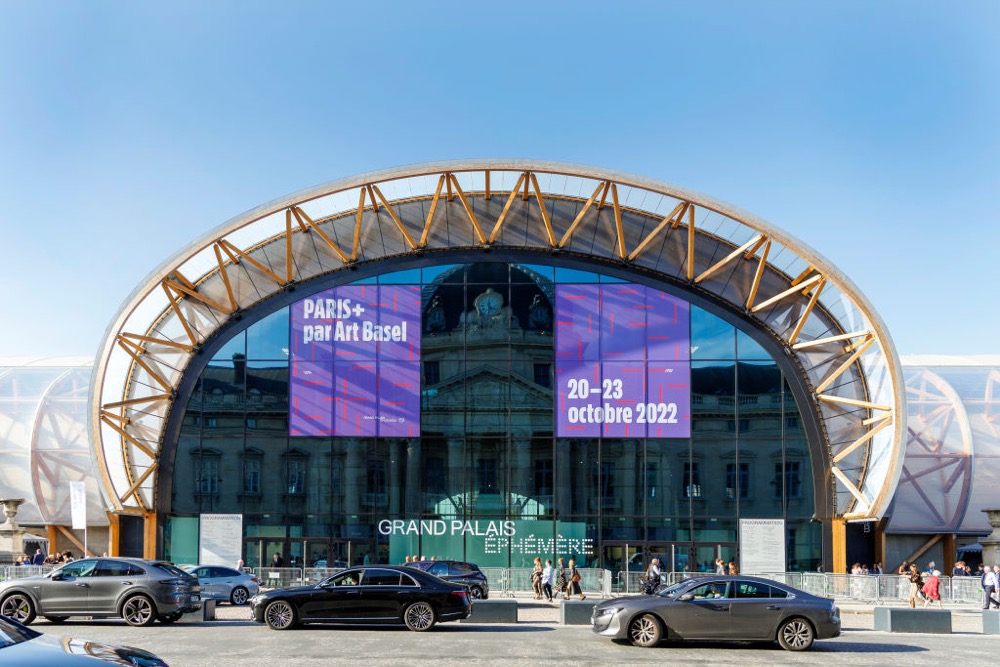Before the Grand Palais reopens in 2024, Paris + par Art Basel is being held for the second year at the Grand Palais éphémère, an artificial building designed by Belgian architect Jean-Michel Wilmotte.
With big crowds expected at the fair, if you feel hemmed in, head outside. Stretching across the Tuileries Garden, from the Louvre to Place de la Concorde, the open-air exhibition “La Cinquième Saison” (The Fifth Season) presents the garden in a new light — “as a mineral, aquatic, vegetal, animal, and human space of activity”.
Curated by Annabelle Ténèze, who took the helm of the Louvre-Lens Museum in July, the exhibition brings together 26 diverse artists to explore the relationship between flora and fauna, the interactions between men and nature, and ideas around change, evolution, and growth. Some artworks even seem to come to life. The experience is a pleasant reprieve of fresh air and art, before diving back into the hustle and bustle of Paris+’s indoor program.
Below are the five must-see installations at the Tuileries Gardens.
Joël Andrianomearisoa, Serenade Serenade – Serenade And The Triumph Of Romance
Made specifically for the fair, Serenade Serenade – Serenade And The Triumph Of Romance (2023) is likely the most poetic work in the exhibition this year. Consisting of fifteen pairs of transparent glass vases displayed on square metallic black structures, the piece sits across from the Gardens’ Apollo and Daphne Fountain, named after the two 1713 statues by Nicolas and Guillaume Coustou that stand in the middle of it. The statues depict the Greek god of light, poetry, and music chasing the nymph that begged to be turned into a laurel tree, so that she would not have to surrender to him.
Andrianomearisoa, a Malagasy artist who lives both in Paris and Antananarivo, drew inspiration from the mythological couple, as well as from other 18th-century love scenes, including Les Progrès de l’Amour (The Progress of Love) by French painter Jean-Honoré Fragonard, to create this delicate installation about courtship, from the first words exchanged by two lovers to their ultimate embrace. The vases have been pierced so that, when it rains, water will pour out of them as out of a fountain. Romantic and hypnotic!
Romina de Novellis x Alberta Pane
The woman shaking a pair of maracas, alone, in the middle of a traditional French bandstand ornamented with colorful tinsels, is Romina de Novellis. The Italian artist and former dancer championed by the Alberta Pane gallery will be in the exact same spot on October 18, 19, and 20 from 3:30 to 5:30 pm. However, her absence is as much a part of the performance as.her presence. The work, titled Voulez-vous danser avec moi ? Merci, je ne préfère pas! (2023)—which translates to “Will you dance with me? No, thanks, I prefer not to!”— interrogates the loneliness one may experience even when surrounded with people. The bandstand is a meeting point, a community-friendly architecture, that comes to life when taken up by musicians and that conversely feels empty when the party leaves.
Meriem Bennani, Windy
Worry not. Windy (2022), Meriem Bennani’s tornado, is harmless. The Brooklyn-based Morrocan artist has a practice rooted in video and originally made this piece—her first sculpture for a public space—for New York’s High Line last year. Bennani has said she sees it as the literal transposition of her 2D animation creations into the real world. Two hundred foam disks spin erratically thanks to the electric engines of ten electric bikes and have been assembled as sequences of a movie. Though it might appear to comment on climate change, the work is actually about materializing movement. Bennani has said her primary source of inspiration was cartoons, where tornados are in fact characters storming in and out of a frame — like the Tasmanian Devil — or regular Joes turning into superheros. The spinning also symbolizes the vicissitudes of life, or what the French call “le tourbillon (whirlwind) de la vie.”
Jean Prouvé and Pierre Jeanneret, Maison F 8×8 BCC
On the left side of the Tuileries Garden, when walking from Place de la Concorde, stands Maison F 8×8 BCC (1942), a wooden demountable house designed by Jean Prouvé (1901-1984), known for combining architecture and engineering in highly aesthetical works. Passerby are welcome to step inside and appreciate the very few pieces of furniture on view—a table topped with monographic books, a large leather couch, and blueprints on the walls.
The 731 square-foot architecture is the product of reflections Prouvé had around 1939 with Pierre Jeanneret, then-director of Le Corbusier’s studio, about how to live better, faster, and at lower cost. Meant for a family of five, Maison F 8×8 BCC revolves around an axial portal frame meant to structure the interior, thus making it easier to navigate. The limited editions of this home, built between 1941 and 1943, are testaments to the duo’s ability to adapt to extreme conditions. Since steel was impossible to source during World War II, they had to figure out a way to make comfortable lodgings in wood. Recent studies have concluded that the design has a low carbon footprint, which bodes well for the future and may be an inspiration for others. Sometimes, the answers are in the past.
Gaetano Pesce, Double Heart
From afar, Double Heart (2022) could be mistaken for a giant lollipop or one of the candy apples Mary Poppins hands Jane and Michael in the eponymous Disney film. This installation, pierced by a cartoonish arrow, actually features a double heart (the title could not be more explicit) that glows day and night. The piece is the monumental version of a lamp that Gaetano Pesce (b. 1939) designed 40 years ago. “I come from Italy and, in Italy, artists, designers, architects don’t differentiate a media from another. If you have a good idea that won’t work for architecture, you express it with design. If you have another one that is good for architecture but not for art, you make an architectural project,” he said in recent interview with Art Basel. Pesce, who rejects labels, is not afraid of being loud, visible, and even “exuberant.” His sixteen-and-half foot beacon of love is proof of that. “This beating heart standing at one of the entrances of the garden gives hope and courage, and we are in much need of that these days”, curator Annabelle Ténèze said at a VIP presentation of the outdoor exhibition.
This content was originally published here.



